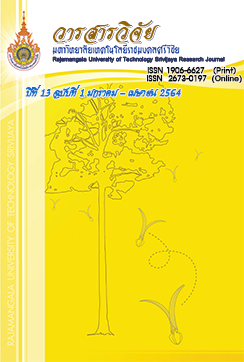Application of Preserved Phytoplankton (Chaetoceros sp.) and Rotifer (Brachionus rotundiformis) in Concentrate Form for Larviculture of Whiteleg Shrimp (Litopenaeus vannamei) and Blue Swimming Crab (Portunus pelagicus)
Keywords:
Chaetoceros sp, Brachionus rotundiformis, Litopenaeus vannamei nursing, Portunus pelagicus nursingAbstract
The objectives of this study were to investigate the preservation of diatom microalgae (Chaetoceros sp.) for whiteleg shrimp (Litopenaeus vannamei) larviculture and of marine rotifer (Brachionus rotundiformis) for blue swimming crab (Portunus pelagicus) larviculture. Both feed stored in concentrate form and by biomass-freezing at -20 ºC with 2% trehalose as cryoprotectant agents (w/w) at 2-4 weeks (T1), 6-8 weeks (T2) and 10-12 weeks (T3) were compared to the traditional method using alive Chaetoceros and alive rotifer (control) to nurse L. vannamei larvae from zoea 1 to post larva stages and P. pelagicus larvae from zoea 1 to magalopa stages, respectively. The results showed that survival rate of shrimp larvae fed with control feed (53.3±11.5%) was significantly higher than those of T1 (0%), T2 (0%) and T3 (0%) (p<0.05) and found that concentrated Chaetoceros affects water quality and quantity of Vibrio bacteria during shrimp larviculture. Additionally, survival rate of blue swimming crab larvae fed with traditional method, T1, T2 and T3 were 26.6±5.7%, 30.0±10.0%, 26.6±11.5% and 23.3±5.7%, respectively. This indicated non-significant (p>0.05) difference. The average of water quality and quantity of Vibrio bacteria in each treatment were not significantly different (p>0.05). This study revealed that there is high possibility to use 2-8 weeks stored rotifer for P. pelagicus larviculture while 2-12 weeks stored Chaetoceros is not possible to use for L. vannamei larviculture.
References
American Public Health Association, American Water Works Association and Water Environment Federation. 2012. Standard methods for the examination of water and wastewater. (22th ed). American Public Health Association, Washington DC.
Araújo, S.D.C. and Garcia, V.M.T. 2005. Growth and biochemical composition of the diatom Chaetoceros cf. wighamii brightwell under different temperature, salinity and carbon dioxide levels. I. Protein, carbohydrate and lipids. Aquaculture 246: 405-412.
Arkronrat, W., Deemark, P., Hengcharoen, N., Pradubtham, K. And Oniam, V. 2014. Cost-benefit analysis of inoculums and mass production of Chaetoceros, pp. 149-156. In The Proceeding of 52nd Kasetsart University Annual Conference. Kasetsart University, Bangkok. (in Thai)
Arkronrat, W., Deemark, P. and Oniam, V. 2016. Usage of trehalose as cryoprotecting agent on preservation of marine microalgae (Chlorella sp. and Chaetoceros calcitrans) in concentrate form, p. 521. In Abstract book of 6th International Fisheries Symposium (IFS 2016). Can Tho University, Can Tho.
Brand, J.J. and Diller, K.R. 2004. Application and theory of algal cryopreservation. Nova Hedwigia 79(1-2): 175-189.
Chuthong, T. 2009. Using of trehalose for increasing efficiency in preservation of frozen natural feed for aquaculture. Master thesis. Kasetsart University, Bangkok. (in Thai)
Heasman, M.P., Sushames, T.M., Diemat, J.A., Connor, W.A.O. and Foulkes, L.A. 2001. Production of Micro-algal Concentrates for Aquaculture Part 2: Development and Evaluation of Harvesting, Preservation, Storage and Feeding Technology. NSW Fisheries, New South Wales.
Oniam, V., Arkronrat, W. And Deemark, P. 2019. Usage of trehalose as cryoprotectant agent on preservation of marine rotifer (Brachionus rotundiformis) in concentrate form at different storage. Journal of Fisheries Technology Research 13(1): 75-81. (in Thai)
Wongrat, L. 2000. Manual of Plankton Culture. Kasetsart University, Bangkok.(in Thai)
Downloads
Published
How to Cite
Issue
Section
License
The content and information in the article published in Journal of Rajamangala University of Technology Srivijaya It is the opinion and responsibility of the author of the article. The editorial journals do not need to agree. Or share any responsibility.







